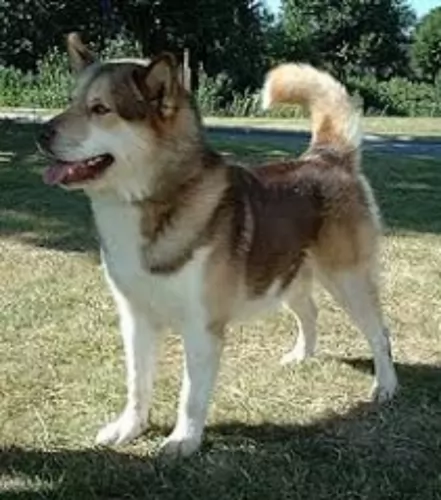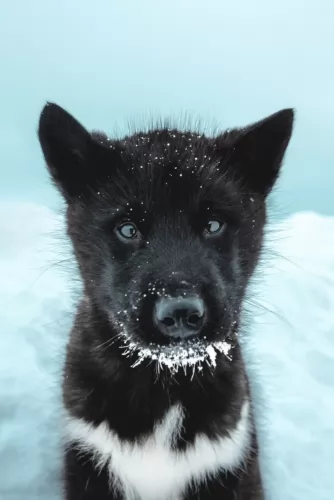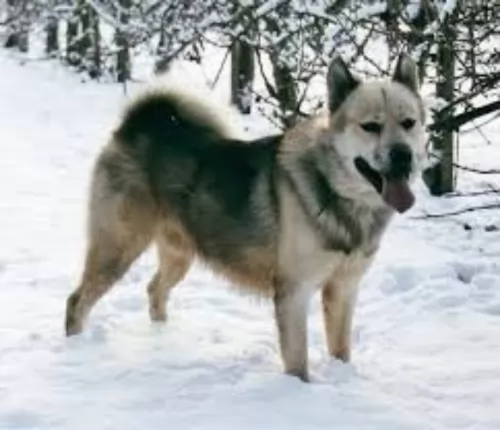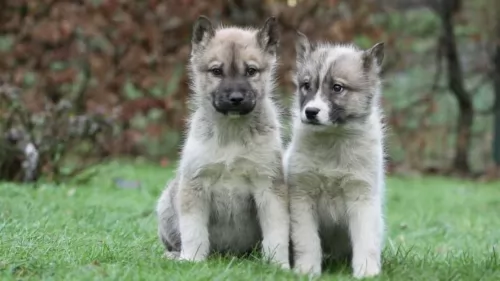 Petzlover
Petzlover Greenland Dog is originated from Greenland but Thai Ridgeback is originated from Thailand. Greenland Dog may grow 7 cm / 3 inches higher than Thai Ridgeback. Both Greenland Dog and Thai Ridgeback are having almost same weight. Both Greenland Dog and Thai Ridgeback has same life span. Both Greenland Dog and Thai Ridgeback has same litter size. Both Greenland Dog and Thai Ridgeback requires Moderate Maintenance.
Greenland Dog is originated from Greenland but Thai Ridgeback is originated from Thailand. Greenland Dog may grow 7 cm / 3 inches higher than Thai Ridgeback. Both Greenland Dog and Thai Ridgeback are having almost same weight. Both Greenland Dog and Thai Ridgeback has same life span. Both Greenland Dog and Thai Ridgeback has same litter size. Both Greenland Dog and Thai Ridgeback requires Moderate Maintenance.
 The Greenland dog is an ancient breed of dog hailing from Greenland. The dog was brought to North American from Siberia hundreds of years ago. In fact the very first dogs arrived in the Americas some 12,000 years ago.
The Greenland dog is an ancient breed of dog hailing from Greenland. The dog was brought to North American from Siberia hundreds of years ago. In fact the very first dogs arrived in the Americas some 12,000 years ago.
The Greenland Dog isn’t recognized by the AKC but it is recognized by a number of other groups. While the Greenland Dog is valued in Greenland, it isn't particularly well known in other parts of the world.
 Until recently the Thai Ridgeback was not known outside of its native land. However, after being recently recognized as a standard breed, the dogs are getting some notice from the western world. They are one of three known ridgeback breeds with the ridge running the opposite direction of the rest of her fur. The other breeds with this characteristic are the better known Rhodesian Ridgeback and the even lesser known Phu Quoc Ridgeback.
Until recently the Thai Ridgeback was not known outside of its native land. However, after being recently recognized as a standard breed, the dogs are getting some notice from the western world. They are one of three known ridgeback breeds with the ridge running the opposite direction of the rest of her fur. The other breeds with this characteristic are the better known Rhodesian Ridgeback and the even lesser known Phu Quoc Ridgeback.
The Thai Ridgeback is believed to have originated in eastern Thailand but there is no documentation of their actual history. The breed is thought to be descended from the Funan Ridgeback based on a genetic hypothesis. It is thought that the same Funan Ridgeback is an ancestor od the Phu Quoc Dog. This Funan Ridgeback lived over a century ago. Along with the Rhodesian Ridgeback, all have a common ridgebearing ancestor.
It is still unknown where the original ridge came from but it has been shown that all of the ridgeback dogs have the same genetic mutation and even though the Rhodisian is from Africa, there is not a parallel mutation. The Thai Ridgeback is an active, energetic, tough dog. He is loyal, intelligent, and has great jumping ability.
 The Greenland Dog is a heavily built dog, and between the males and females, this medium to large sized dog can be 51 – 68cm in height and weigh 30 – 35kg.
The Greenland Dog is a heavily built dog, and between the males and females, this medium to large sized dog can be 51 – 68cm in height and weigh 30 – 35kg.
He has the typical slanted eyes of the husky-type dogs with a keen, alert expression in them. He has small triangular erect ears. The long, bushy tail of the dog is curled over the back of the dog.
The coat is short to medium length and has 2 layers with the outer layer being fairly coarse. The double coat is thick and shortish but also stand-offish, meaning the hair doesn’t lie flat against the dog’s body. Color of the fur is a mix of cream, beige, white, tan, black, grey or silver.
As a working dog, the Greenland Dog is known for its strength, its boisterous nature and speed. Because its a dog that has worked as a pack, it wants a firm, patient, fair, confident owner to bring out the best in him. Being intelligent, independent and work-orientated, it is perhaps not a great choice for the first-time dog owner who may be out of their realm with the demands of these high-energy dogs.
The dog is independent, but he is quite capable of forming a strong, loving bond with his owner. This is certainly a dog that is never going to thrive if he has to lie around the house all day – he is an active dog who wants a task to do and he is going to need plenty of daily exercise.
They’ve always had active lives pulling sleds or hunting for seals and he craves this busy, active lifestyle. He is the kind of dog that shouldn’t live in the city with a tiny garden unless he has an owner who takes time to walk him and exercise him vigorously. He is a dog that will require training and socialization.
 The breed is medium in size and muscular in body. They have a wedge shaped head, a short coat that is smooth and pricked, triangular ears. The ridge on his back is pronounced as the hair grows away from the rest of the coat from the hips to the withers. Puppies can be born with or without the ridge. They are extremely agile. With what is often called a sword tail being carried up, the Ridgeback has wrinkles on his forehead, a black tongue or the tongue has black marks, and almond shaped eyes.
The breed is medium in size and muscular in body. They have a wedge shaped head, a short coat that is smooth and pricked, triangular ears. The ridge on his back is pronounced as the hair grows away from the rest of the coat from the hips to the withers. Puppies can be born with or without the ridge. They are extremely agile. With what is often called a sword tail being carried up, the Ridgeback has wrinkles on his forehead, a black tongue or the tongue has black marks, and almond shaped eyes.
The coat sheds minimally and is dense, while the eyes are usually brown – in blue dogs they can be amber. The color of the coat is fawn, red, black or blue with a black mask on the reds. There are 8 different ridge patterns: Feather, violin, saddleback, needle, arrow, bowling pin, lute, and leaf. The broader the ridge the better the dog is considered for show.
There are two epistatic genes that determine the ridge and its size. The more genes of this type the individual dog has, the broader the ridge will be. There must be a dominant gene for the ridge to appear at all.
 Bred as a working dog, the Greenland Dog, native to Greenland is a high energy dog who is boisterous, lively and social. With training and socialization, he becomes an obedient, loyal and devoted pet.
Bred as a working dog, the Greenland Dog, native to Greenland is a high energy dog who is boisterous, lively and social. With training and socialization, he becomes an obedient, loyal and devoted pet.
While he is quite capable of being an awesome domesticated pet, he is essentially a working dog, loving having to be part of a very active lifestyle. He may not be the best pet for a first time owner or a home with small children. This is because he isn't your cuddly, lying-around-the-house, playmate kind of pet. He wants a home and owner similar to himself – strong, active, energetic, bold, independent, strong-willed and firm, and when he gets this, he becomes the splendid pet he is so well known for.
 Your Greenland dog can battle with eye problems such as progressive retinal atrophy, hereditary or juvenile cataracts and corneal dystrophy. Eye diseases like this can cause a host of problems for your pet and should receive immediate veterinary attention.
Your Greenland dog can battle with eye problems such as progressive retinal atrophy, hereditary or juvenile cataracts and corneal dystrophy. Eye diseases like this can cause a host of problems for your pet and should receive immediate veterinary attention.
Cataracts in dogs are a common problem affecting the eyes of dogs, with there being different forms and causes.The age at which your pet develops cataracts is important for identifying the type of cataract it is because it will give the vet an idea if the cataracts are an hereditary trait in certain dog breeds.
Nearly every dog can battle with hip dysplasia and it can be a serious concern for active canines such as the Greenland dog.
This joint and bone ailment can start manifesting itself as early as 4 months of age with your pet. This dysplasia occurs when the head of the femur doesn't fit into the pelvic joint the way it should. It can lead to pain, arthritis and lameness with your dog.
 With such a mysterious origin, there are not a lot of documented episodes of genetic illness as the breed has been isolated in Thailand and natural selection has driven reproduction. There are only a few issues that they are genetically predisposed to. These include:
With such a mysterious origin, there are not a lot of documented episodes of genetic illness as the breed has been isolated in Thailand and natural selection has driven reproduction. There are only a few issues that they are genetically predisposed to. These include:
• Dermoid Sinus – this is a genetic skin condition known as pilonidal sinus as well. This is a defect in the neural tube and the sinus might be removed. If the sinus is wrapped around the spinal cord and cannot be removed it can be tied off.
• Bloat – can be terminal if not treated as soon as possible. Bloat is a distension of the stomach and intestines which can twist and tangle, killing the dog almost immediately without veterinary attention.
 As a medium- to large-sized dog breed, the Greenland Dog will require a high-quality commercial dog food if that is what you will be feeding him. The top quality brands have the right mix of vitamins and minerals in them for health.
As a medium- to large-sized dog breed, the Greenland Dog will require a high-quality commercial dog food if that is what you will be feeding him. The top quality brands have the right mix of vitamins and minerals in them for health.
However, it is wise to ensure that such an active dog breed gets his quota of raw meat in too. He has been used to eating fish and seal meat and will require this raw diet too. Sometimes if you cook rice, chicken and vegetables, you can add this into his kibble too.
Greenland Dogs need to be groomed at least twice a week to keep the thick coat in tip top condition. He sheds throughout the year.
He will also require you brushing his teeth to get rid of plaque which can cause a host of health issues. You get special toothpaste and toothbrush for dogs. His teeth should be brushed 2 or 3 times a week.
Make sure you give your high-energy Greenland Dog the right dose of exercise. He is intelligent too so he needs walks, games and other activities that contribute towards his physical and mental wellbeing.
He will do well on large properties or farms but won't do well where the space is tiny and where the owners are inactive couch potatoes.
Be careful too that the Greenland Dog isn't exercised immediately after eating as this puts him in danger of developing bloat.
 1. Feeding the Puppy - Don’t over feed the puppy as they are inclined to become obese. Feed a high quality protein rich puppy for medium breeds. Feed in 3-4 smaller meals per day. As he grows be aware of bloat possibilities.
1. Feeding the Puppy - Don’t over feed the puppy as they are inclined to become obese. Feed a high quality protein rich puppy for medium breeds. Feed in 3-4 smaller meals per day. As he grows be aware of bloat possibilities.
2. Feeding the adult dog - The risk of bloat is even greater in the adult and so is the risk of obesity. Don’t feed large meals and don’t feed before or after strenuous exercise. Feed in 2 smaller meals per day.
4. Games and Exercises – Energetic and needs serious exercise. She loves to swim, retrieve, hike, hunt, and catch frisbees. Likes search and rescue and guard dog work.